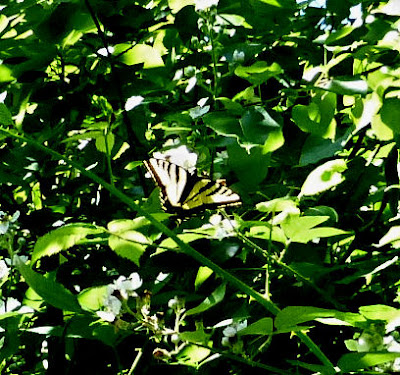Over the last week Sandra and I have made it out to a couple of the local parks looking for birds and butterflies. If we had been looking for the birds and the bees,we would have had better luck, as there are plenty of honey bees and bumblebees.
 |
| Tiger Swallowtail Nectaring on Blackberry Blossoms 6/21 |
On the far side of the cottonwood forest is a man made meadow about fifty yards across and stretching about half a mile up river. There is a large patch of white clover with dandelions, a few clumps of willows with wild roses and blackberries growing along the margins. Just past a narrow break of cottonwoods and willows flows the mighty Columbia.
 |
| Western Tiger Swallowtail, Washougal Wa. June 2021 |
On our first day in the park, we saw a yellow warbler in the willows near the river and heard a large (or at least loud) woodpecker which I assumed was a pileated. On this day we were able to approach one butterfly nectaring on blackberry blossoms. I captured him on my cell phone camera, only to find that this image was so poor that it would never make it into the blog.
Back at the tiny condo, Sandra and I reconsidered our approach. Mostly this involved charging our Panasonic Lumix and mobilizing a second pair of binoculars. All of which leads us to yesterday.
We returned to Clark Park on a glorious morning. From the top of the dike Mt Hood rose majestically in the east. We made our way through the cottonwoods into the meadow. Once again, there were no butterflies on the low lying clover, but plenty flitting through the willows. soon we were able to track a few butterflies nectaring on blackberry blossoms.
 |
| The ubiquitous Song Sparrow, Washougal, Wa. 6/21 |
Eventually we sat on one of the many tables and enjoyed our lunch, during which I pulled out my cell phone. Since it had failed in the photographic department, the phone was relegated to Google searching. Wondering why there were so many tiger swallowtails here, Sandra had wondered just what were their host plants. Mr. Google had a surprise in store. Western Tiger Swallowtails may use a variety of trees for a host plant, including alders, which are common enough in Western Washington, but the plant at the top of the list is cottonwoods. Mystery solved.
Western Tiger Swallowtail is one of many butterflies that hibernate in the chrysalis. Its possible that in just the past few days, as the blackberries have started to bloom, that these handsome butterflies have emerged, stretched their wings and filled the meadows adjacent to their stands of cottonwood.
 |
| Better to enjoy the beauty of a wild rose than the Columbia River bathers |
there is a narrow sandy beach. We saw not a few people hanging around in bathing suits apparently preparing for a swim. On our way to the car, we encountered a mother with four children ages 4 through 7 each wearing a life jacket. Those of us from Hawaii, will think that 60 degree water is less than perfect. But apparently that is the Columbia River temperature at Portland in June and this hardy breed swims in it. If nothing else, this will put things in perspective when I complain about cold ocean water next winter.
jeff
No comments:
Post a Comment